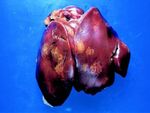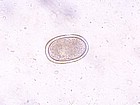Difference between revisions of "Histomonas"
Jump to navigation
Jump to search
| Line 71: | Line 71: | ||
[[Category:Miscellaneous_Protozoa]] | [[Category:Miscellaneous_Protozoa]] | ||
| + | |||
| + | [[Category:To_Do_-_Parasites]] | ||
Revision as of 22:16, 26 June 2010
Histomonas meleagridis
- Infects chickens and turkeys
- Causes Blackhead in turkeys
- Infectious entero-hepatitis or histomonosis
- Head and wattle become cyanotic
- Worldwide distribution
Recognition
- 10-25μm long
- Round or oval
- 1 flagellum in the intestinal form
- The tissue form has no flagellum
- Pseudopial movement
Life Cycle
- Histomonas carried by larval stage inside the egg of the caecal nematode worm Heterakis gallinarum (vector)
- Histomonas released from larva when egg hatches in intestine
- Penetrates caecal wall
- Carried by hepatic portal system to the liver parenchyma
- Intestinal Histomonas infects Heterakis gallinarum and passes to worm ovary
- Worm passes Histomonas-infected eggs in droppings
- Infected eggs swallowed by birds or earthworms
- Earthworms act as transport hosts carrying larvae in their tissues
Pathogenicity
- Necrotic circular caecal lesions and liver lesions
- Lesions begin small but soon enlarge and become necrotic
- The plug detaches with the caecal contents forming a caseous plug
- Lesions can be up to 1cm in diameter
- Lesions found both on the surface and in the substance of the liver
- Mortality may reach 100%
- Generally affects turkey poults under 14 weeks old
- A few days after infection the bird will become dull with ruffled feathers
- The faeces will become sulphur yellow in colour
- In older turkeys, recovery and immunity is likely
Diagnosis
- Clincal signs
- Cyanotic head and wattles
- Yellow droppings
Control
- Do not rear turkeys on ground used by chickens
- Chickens are asymptomatic carriers
- Chemical control now withdrawn due to fears of human toxicity

